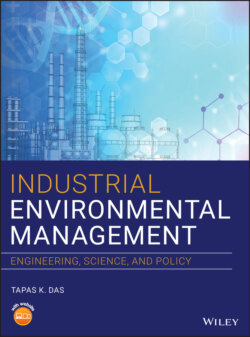Читать книгу Industrial Environmental Management - Tapas K. Das - Страница 59
2.2 Genesis of the Environmental Problem
ОглавлениеEnvironmental problems have bedeviled humanity since the first person discovered fire. The earliest humans appear to have inhabited a variety of locales within a tropical and semitropical belt stretching from Ethiopia to southern Africa about 1.9 million years ago. These first humans provided for themselves by a combination of gathering food and hunting animals. Humans, for the majority of their two million years' existence, lived in this manner. The steady development and dispersion of these humans was largely due to an increase in brain size. This led to the ability to think abstractly, which was vital in the development of technology and ability to speak. This in turn led to cooperation and more elaborate social organization. The ability to use and communicate and the developed technology to overcome the hostile environment ultimately led to the expansion of these first human settlements (Ponting 1991; Sander and Theodore 2008).
By about 10 000 years ago humans had spread over every continent, living in small mobile groups. A minority of these groups lived in close harmony with the environment and did minimum damage. Evidence has been found where groups tried to conserve resources in an attempt to maintain subsistence for long periods of time. In some cases, restrictions on hunting a particular species at a time, a certain period of time of the year, or only in a certain area every few years helped to maintain population levels of certain animals (Goudie 1981). The Cree in Canada used a form of rotational hunting, only returning to an area after a considerable length of time, which allowed animal populations to recover. But the majority of these groups exploited the environment and animals inhabiting it. In Colorado, bison were often hunted by stampeding them off a cliff, ending up with about 200 corpses, most of which could not be used. On Hawaii, within a 1000 years of human settlement, 39 species of land birds had become extinct (Ponting 1991). In Australia, over the last 100 000 years, 86% of the large animals have become extinct. The large number of species lost was largely due to tendency for hunters to concentrate on one species to the exclusion of others. The main reason why these groups avoided further damage to nature was the fact that their numbers were so small that the pressure they exerted on the environment was limited.
The major shift in human evolution took place between 10 000 and 12 000 years ago. Humans learned how to domesticate animals and cultivate plants and in so doing made a transition from nomadic hunter‐gatherer to rooted agriculturist. The global population at this time was about four million people, which was about the maximum that could readily be supported by a gathering and hunting way of life (Ponting 1991). The increasing difficulty in obtaining food is believed to be a major contributor to this sudden change. The farmer changed the landscape of the planet and was far more destructive than the hunter. While farming fostered the rise of cities and civilizations, it also led to practices that denuded the land of its nutrients and water‐holding capacity. Great civilizations flourished and then disappeared as once‐fertile land, after generations of over‐farming and erosion, was transformed into barren wasteland.
However, many years later different dimensions of the problem of environmental protection and its management have taken a serious turn in the present era. This is so because humans' interaction with the natural environment is so extensive that the environment question has assumed proportions affecting all humanity. The dominant factors which are responsible to environmental deterioration throughout the world are rapid industrialization, urbanization, population explosion (Figure 2.1), poverty, over‐exploitation of resources, depletion of traditional resources of energy and raw materials, and research for new sources of energy and raw materials.
As a result of this, there is air pollution, water pollution, noise pollution, land pollution, and so on. The list is virtually endless. Moreover, the seriousness of environmental problem may be judged in terms of knowledge and skills required to understand a particular issues demanding solution. In order to achieve sustainable development, environmental protection constitutes an integral part of development process and it cannot be considered in isolation. Peace, development, and environment are interdependent and indivisible (Rio Declaration, UNESCO 1992). In the same continuation, Earth Summit of 1992 in Rio de Janerio, through Rio Declaration and agenda 21 has further concretized the concept of environmental protection and sustainable development essential to survival of human race. Today we are confronted with a perpetuation of disparities between and within nations, a worsening of poverty among developing countries, hunger, ill health due to malnutrition, poor sanitation and lack of safe drinking water and proper health care, illiteracy, and continuing deterioration of the ecosystem on which we depend for our well‐being. However, integration of environment and development concerns and greater attention to them will lead to the fulfillment of basic needs, improved living standards for all, better protected and managed ecosystems, and a safer, more prosperous future.
